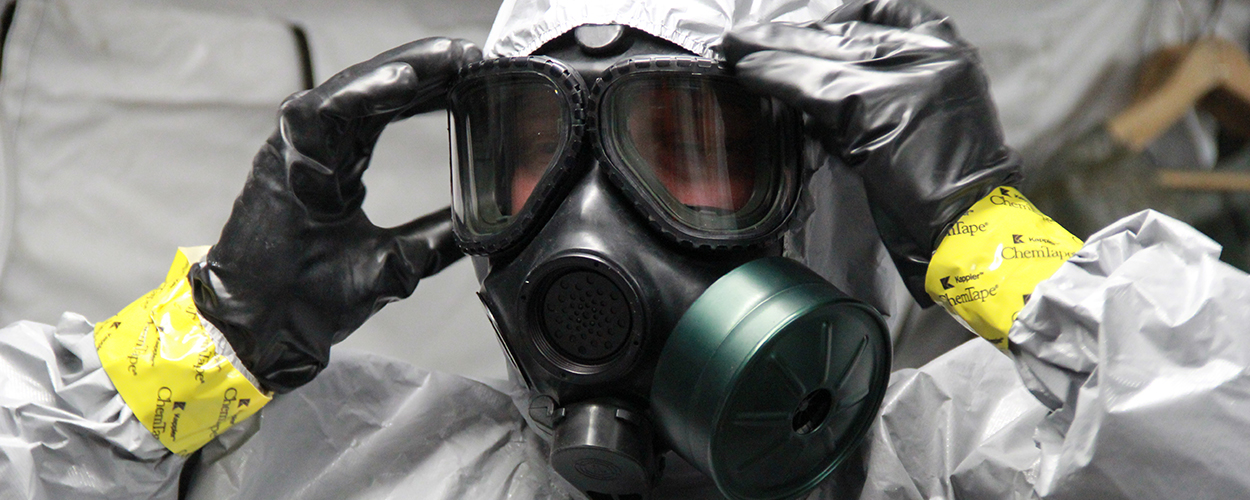Social Distancing Inspires New Ways to Conduct Training
Social Distancing Inspires New Ways to Conduct Training
Respiratory Protection Program continues critical mission
By Jerilyn Coleman
As the U.S. Army’s Combat Capabilities Development Command Chemical Biological Center (DEVCOM CBC) continues to redefine workspaces and processes during the COVID-19 pandemic, its employees are executing the Center’s mission in the face of adversity. Among those professionals are the protective mask experts in the Chemical Biological Application and Risk Reduction (CBARR) unit, who have created new ways to conduct training for the Respiratory Protection Program (RPP).
CBARR issues personal protective equipment (PPE) for research that directly supports the warfighter. In addition to issuing PPE, CBARR’s Mask Issue and Mobility Team also trains personnel on how to use the equipment.
During the pandemic, mandated social distancing and telework made conducting the RPP difficult. “As the shutdown progressed it was identified that essential personnel on post needed their annual training as well as fit tests in order to continue the activities they were tasked,” said Ed Parshley, supervisor of Mask Issue and Mobility for the Operational Applications Directorate.
Recognizing these concerns, Parshley and his team began identifying ways to provide the training while also adhering to social distancing guidelines.
The RPP is designed for individuals whose duties may bring them in contact with chemical agents. At some point, they may have to wear respiratory protection, otherwise known as masks. The training includes how to sanitize, inspect, don, and doff the mask, as well as what mask is needed for specific situations and environments. For instance, if a warfighter or laboratory technician is in an environment that is immediately dangerous to life and health (IDLH), then an air purifying respirator is authorized for escape purposes only. In cases where cleanup operations need to be performed in an IDLH environment, a supplied air breathing apparatus with an airline or a self-contained breathing apparatus may be used.
Typically, trainees complete the RPP in-person and get fit-tested in order to receive a new mask to maximize the amount of time they can keep it. Since the pandemic, a limited number of people were allowed in the training room. First, it was limited to 10 people, then it decreased to six in a room that typically holds 16 people. To combat this, the Mask Issue and Mobility Team started to schedule personnel for training sessions. “Before we set specific hours, personnel would show up and you had a seat to take the training. But in the new environment we had to start scheduling people to do the training,” Parshley said.
Once access to the installation was restricted due to the pandemic, personnel weren’t available to train on-site. At the time, there wasn’t an online capability for the training. Ultimately, the team made the decision to move forward and maintain the RPP requirement as best as they could with the resources they had. Parshley recognized that Social Distancing Inspires New Ways to Conduct Training Respiratory Protection Program continues critical mission the Center’s IT staff had other complex Centerwide challenges that took precedence, so he used his computer skills to find innovative solutions to continue the mission.
Through the team’s investigation and collaborative thinking, they discovered that Microsoft Teams had the capability to upload files and record video calls, which led to Parshley experimenting with the video share feature. “I just played the video, turned my microphone off, recorded the entire session, then uploaded the file to the MS Teams file folder so that it allowed people to view the videos in the order they chose, and the time they chose to take it,” Parshley explained.
The next thing they had to figure out was how to get people to join the MS Teams meetings and verify attendance. They sent invitations to the workforce required to take respiratory training and verified that a trainee actually watched the video by embedding a code in the last video at the end of the training. That final video then took trainees to a new MS Teams session that included an uploaded test.
MS Teams hasn’t become a certified platform for RPP training yet, and CBARR’s Mask Issue and Mobility Team will revert to the traditional RPP training once the installation’s Health Protection Condition status allows them to do so; however, this new process could still be an option for employees who cannot train in person. “MS Teams is a good alternative to provide this training. It is a very good tool and should be considered as a usable source,” Parshley said.
The Chemical Biological Application and Risk Reduction (CBARR) Mask Issue and Mobility team provides personal protective equipment for research that supports warfighter safety.

